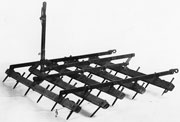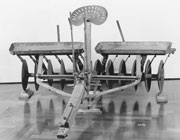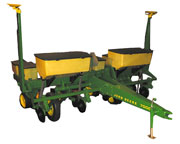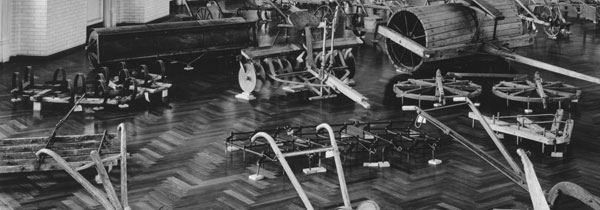
George
Geddes patented this expandable harrow in about 1835.

Farmers liked this style of harrow in fields free
of obstructions.

The spring
steel teeth of this harrow effectively rip apart the soil.

Late in the 1800s, farm machinery companies marketed
harrows comprised of rolling disks.

Today, planters that prevent erosion use
discs like a disc harrow to help break the soil before planting the
seeds.
|
|
“The best crops
are raised with least labor…by breaking it up just before
planting; and having rolled or bushed it, drag it with a harrow till
it is mellow.”
Benjamin Sommers, Erie County Ohio farmer, December
10, 1850
American inventors sought to create machines
that performed work efficiently. Farmers wanted the most
affordable and effective implement possible. The earliest wooden
and iron harrows used a triangular design. This style arose out
of necessity, as the first European-American settlers had difficulty
removing stumps from their newly-established fields. Triangular
harrows did not catch on the stumps, but rebounded away without damaging
the tool or hurting the draft animals. A later development by
George Geddes allowed the legs of the harrow to expand or contract
so that the harrow best fit the distance between rows of planted crops
such as corn or tobacco. Farmers adjusted the legs in or out
so that a team of draft animals could pull this harrow between rows
to remove weeds.
As farm families cleared the stumps from the fields on the established
farms or settled treeless regions like the prairies, harrows returned
to traditional European styles or took on new designs. Rectangular
frame harrows made of wood, iron and, later, steel -- called “Scotch” or “spike
tooth” harrows -- proved popular. This type of harrow and
variations on it remained in common use into the 1900s. It is likely
young Henry Ford walked behind a harrow similar to a Scotch harrow as
he helped cultivate his father’s fields.
Changes in materials also contributed to new types of harrows. By
the 1880s, machinery companies manufactured “spring tooth” harrows. These
implements retained the rectangular frame of their predecessors, but
used gracefully curved “spring steel” teeth that ripped the
soil and broke apart the clods. The spring steel teeth proved more
durable than metal spikes as the material was less brittle than iron
and conventional steel. By the early 1900s, this type of
harrow could be found in the machine sheds and fields of many American
farmers.
Contemporary with the spring tooth harrow, the disk harrow offered another
design innovation. Rolling steel discs cut and pulverized
clods of dirt. These harrows worked well in soil free of stones,
as they severed the roots of any existing plant as the farmer prepared
the field for planting. Disc harrows often featured another
convenience for the farmer: a seat! Farmers increasingly farmed
sitting down, eliminating some of the drudgery Henry Ford so disliked.
Farmers continue to use harrows, though not as much as in the past. Harrows
expose top soil to wind and water erosion. Many mechanical planters
used today incorporate rolling discs of the disc harrow to help break
up the soil and open a small hole in the soil immediately before planting
the seeds. Rolling disks then cover the seeds. These conservation
tillage planters are now standard on the majority of farms in the United
States . The John Deere Company’s No-Till planter, manufactured
in 1979, uses this system.
Henry Ford believed people can be inspired by ordinary objects. These
harrows inform us where we have been but, like Henry Ford, we hope they
inspire you to change people’s lives. Whether it be Thomas
Edison’s electric light bulb, the Rosa Parks Bus, or a harrow from
the 1850s, we can draw ideas from ordinary things and be inspired to
create a better world.
Leo Landis
Curator
of Agriculture & Rural Life
|


